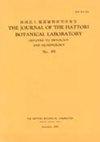THE FUNCTION OF ABSCISIC ACID IN BRYOPHYTES
引用次数: 7
Abstract
Abscisic (ABA) acid has been detected in all members of Bryophyta which have been analysed until now. Highest ABA contents were detected in species that were adapted to dry environmental conditions, lowest amounts were found in aquatic and hydrophilic species. Abscisic acid seems to be involved in several ecophysiological and developmental processes. I) ABA induces stomata! closure in stomata-bearing sporophytes of Anthocerotae and Musci; 2) ABA induces desiccation tolerance in several drought resistant members of the Marchantiales and in Funaria-protonemata. 3) ABA converts the waterform of Riccia fiuitans L. (submerged living) and Ricciocarpus natans L.Corda (floating on the water surface) into the landform. Ecophysiological as well as molecular biological experiments will be discussed.脱落酸在苔藓植物中的作用
在苔藓植物的所有成员中均检测到脱落酸(ABA)。适应干燥环境的品种ABA含量最高,水生和亲水品种ABA含量最低。脱落酸似乎参与了几个生态生理和发育过程。1) ABA诱导气孔!石竹科和麻科的气孔孢子体闭合;2) ABA诱导了Marchantiales和Funaria-protonemata几个抗旱成员的干燥耐受性。3) ABA将Riccia fiuitans L.(水下生活)和Ricciocarpus natans L. corda(漂浮在水面上)的水形态转化为地貌。生态生理学以及分子生物学实验将被讨论。
本文章由计算机程序翻译,如有差异,请以英文原文为准。
求助全文
约1分钟内获得全文
求助全文

 求助内容:
求助内容: 应助结果提醒方式:
应助结果提醒方式:


